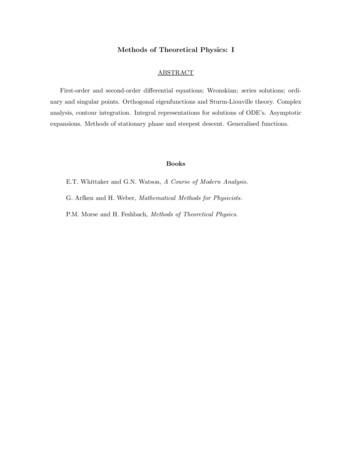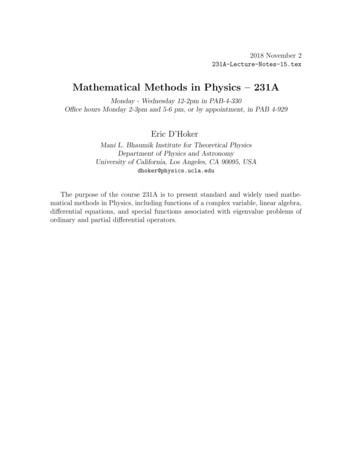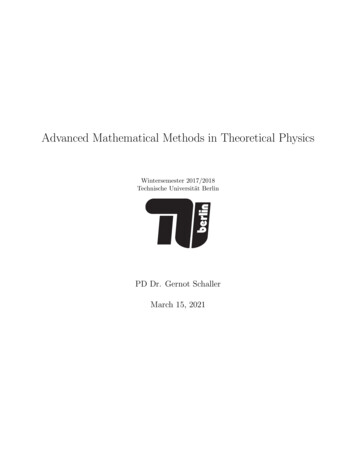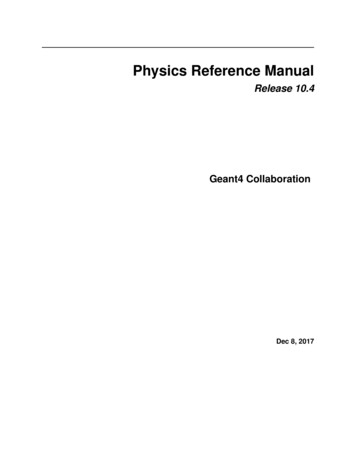
Transcription
Methods of Theoretical Physics: IABSTRACTFirst-order and second-order differential equations; Wronskian; series solutions; ordinary and singular points. Orthogonal eigenfunctions and Sturm-Liouville theory. Complexanalysis, contour integration. Integral representations for solutions of ODE’s. Asymptoticexpansions. Methods of stationary phase and steepest descent. Generalised functions.BooksE.T. Whittaker and G.N. Watson, A Course of Modern Analysis.G. Arfken and H. Weber, Mathematical Methods for Physicists.P.M. Morse and H. Feshbach, Methods of Theoretical Physics.
Contents1 First and Second-order Differential Equations31.1The Differential Equations of Physics . . . . . . . . . . . . . . . . . . . . . .31.2First-order Equations4. . . . . . . . . . . . . . . . . . . . . . . . . . . . . .2 Separation of Variables in Second-order Linear PDE’s72.1Separation of variables in Cartesian coordinates . . . . . . . . . . . . . . . .72.2Separation of variables in spherical polar coordinates . . . . . . . . . . . . .102.3Separation of variables in cylindrical polar coordinates . . . . . . . . . . . .123 Solutions of the Associated Legendre Equation133.1Series solution of the Legendre equation . . . . . . . . . . . . . . . . . . . .133.2Properties of the Legendre polynomials. . . . . . . . . . . . . . . . . . . .193.3Azimuthally-symmetric solutions of Laplace’s equation . . . . . . . . . . . .243.4The generating function for the Legendre polynomials . . . . . . . . . . . .273.5The associated Legendre functions . . . . . . . . . . . . . . . . . . . . . . .293.6The spherical harmonics and Laplace’s equation . . . . . . . . . . . . . . . .323.7Another look at the generating function . . . . . . . . . . . . . . . . . . . .364 General Properties of Second-order ODE’s394.1Singular points of the equation . . . . . . . . . . . . . . . . . . . . . . . . .404.2The Wronskian . . . . . . . . . . . . . . . . . . . . . . . . . . . . . . . . . .424.3Solution of the inhomogeneous equation . . . . . . . . . . . . . . . . . . . .474.4Series solutions of the homogeneous equation . . . . . . . . . . . . . . . . .494.5Sturm-Liouville Theory . . . . . . . . . . . . . . . . . . . . . . . . . . . . .655 Functions of a Complex Variable965.1Complex Numbers, Quaternions and Octonions . . . . . . . . . . . . . . . .965.2Analytic or Holomorphic Functions . . . . . . . . . . . . . . . . . . . . . . .1075.3Contour Integration . . . . . . . . . . . . . . . . . . . . . . . . . . . . . . .1145.4Classification of Singularities . . . . . . . . . . . . . . . . . . . . . . . . . .1265.5The Oppenheim Formula . . . . . . . . . . . . . . . . . . . . . . . . . . . .1405.6Calculus of Residues . . . . . . . . . . . . . . . . . . . . . . . . . . . . . . .1445.7Evaluation of real integrals . . . . . . . . . . . . . . . . . . . . . . . . . . .1455.8Summation of Series . . . . . . . . . . . . . . . . . . . . . . . . . . . . . . .1561
5.9Analytic Continuation . . . . . . . . . . . . . . . . . . . . . . . . . . . . . .1595.10 The Gamma Function . . . . . . . . . . . . . . . . . . . . . . . . . . . . . .1635.11 The Riemann Zeta Function . . . . . . . . . . . . . . . . . . . . . . . . . . .1705.12 Asymptotic Expansions . . . . . . . . . . . . . . . . . . . . . . . . . . . . .1795.13 Method of Steepest Descent . . . . . . . . . . . . . . . . . . . . . . . . . . .1836 Non-linear Differential Equations1896.1Method of Isoclinals . . . . . . . . . . . . . . . . . . . . . . . . . . . . . . .1906.2Phase-plane Diagrams . . . . . . . . . . . . . . . . . . . . . . . . . . . . . .1947 Cartesian Vectors and Tensors1967.1Rotations and reflections of Cartesian coordinate . . . . . . . . . . . . . . .1967.2The orthogonal group O(n), and vectors in n dimensions . . . . . . . . . . .1997.3Cartesian vectors and tensors . . . . . . . . . . . . . . . . . . . . . . . . . .2017.4Invariant tensors, and the cross product . . . . . . . . . . . . . . . . . . . .2057.5Cartesian Tensor Calculus . . . . . . . . . . . . . . . . . . . . . . . . . . . .2132
1First and Second-order Differential Equations1.1The Differential Equations of PhysicsIt is a phenomenological fact that most of the fundamental equations that arise in physicsare of second order in derivatives. These may be spatial derivatives, or time derivatives invarious circumstances. We call the spatial coordinates and time, the independent variablesof the differential equation, while the fields whose behaviour is governed by the equationare called the dependent variables. Examples of dependent variables are the electromagnetic potentials in Maxwell’s equations, or the wave function in quantum mechanics. It isfrequently the case that the equations are linear in the dependent variables. Consider, forexample, the scalar potential φ in electrostatics, which satisfies 2 φ 4π ρ(1.1)where ρ is the charge density. The potential φ appears only linearly in this equation, whichis known as Poisson’s equation. In the case where there are no charges present, so that theright-hand side vanishes, we have the special case of Laplace’s equation.Other linear equations are the Helmholtz equation 2 ψ k2 ψ 0, the diffusion equation 2 ψ ψ/ t 0, the wave equation 2 ψ c 2 2 ψ/ t2 0, and the Schrödinger equation h̄2 /(2m) 2 ψ V ψ ih̄ ψ/ t 0.The reason for the linearity of most of the fundamental equations in physics can be tracedback to the fact that the fields in the equations do not usually act as sources for themselves.Thus, for example, in electromagnetism the electric and magnetic fields respond to thesources that create them, but they do not themselves act as sources; the electromagneticfields themselves are uncharged; it is the electrons and other particles that carry chargesthat act as the sources, while the photon itself is neutral. There are in fact generalisationsof Maxwell’s theory, known as Yang-Mills theories, which play a fundamental rôle in thedescription of the strong and weak nuclear forces, which are non-linear. This is preciselybecause the Yang-Mills fields themselves carry the generalised type of electric charge.Another fundamental theory that has non-linear equations of motion is gravity, describedby Einstein’s general theory of relativity. The reason here is very similar; all forms of energy(mass) act as sources for the gravitational field. In particular, the energy in the gravitationalfield itself acts as a source for gravity, hence the non-linearity. Of course in the Newtonianlimit the gravitational field is assumed to be very weak, and all the non-linearities disappear.In fact there is every reason to believe that if one looks in sufficient detail then eventhe linear Maxwell equations will receive higher-order non-linear modifications. Our best3
candidate for a unified theory of all the fundamental interactions is string theory, and theway in which Maxwell’s equations emerge there is as a sort of “low-energy” effective theory,which will receive higher-order non-linear corrections. However, at low energy scales, theseterms will be insignificantly small, and so we won’t usually go wrong by assuming thatMaxwell’s equations are good enough.The story with the order of the fundamental differential equations of physics is rathersimilar too. Maxwell’s equations, the Schrödinger equation, and Einstein’s equations are allof second order in derivatives with respect to (at least some of) the independent variables. Ifyou probe more closely in string theory, you find that Maxwell’s equations and the Einsteinequations will also receive higher-order corrections that involve larger numbers of time andspace derivatives, but again, these are insignificant at low energies. So in some sense oneshould probably ultimately take the view that the fundamental equations of physics tend tobe of second order in derivatives because those are the only important terms at the energyscales that we normally probe.We should certainly expect that at least second derivatives will be observable, sincethese are needed in order to describe wave-like motion. For Maxwell’s theory the existenceof wave-like solutions (radio waves, light, etc.) is a commonplace observation, and probablyin the not too distant future gravitational waves will be observed too.1.2First-order EquationsDifferential equations involving only one independent variable are called ordinary differentials equations, or ODE’s, by contrast with partial differential equations, or PDE’s, whichhave more than one independent variable. Even first-order ODE’s can be complicated.One situation that is easily solvable is the following. Suppose we have the single firstorder ODEdy(x) F (x) .dxThe solution is, of course, simply given by y(x) Rx(1.2)dx′ F (x′ ) (note that x′ here is just aname for the “dummy” integration variable). This is known as “reducing the problem toquadratures,” meaning that it now comes down to just performing an indefinite integral.Of course it may or may not be be that the integral can be evaluated explicitly, but that isa different issue; the equation can be regarded as having been solved.The most general first-order ODE takes the formdy(x) F (x, y) .dx4(1.3)
A special class of function F (x, y) for which we can again easily solve the equation explicitlyis ifF (x, y) P (x),Q(y)(1.4)implying that (1.3) becomes P (x) dx Q(y) dy 0, since then we can reduce the solutionto quadratures, withZxdx′ P (x′ ) Zydy ′ Q(y ′ ) 0 .(1.5)Note that no assumption of linearity is needed here.A rather more general situation is whenF (x, y) P (x, y),Q(x, y)(1.6)and if the differential P (x, y) dx Q(x, y) dy is exact, which means that we can find afunction ϕ(x, y) such thatdϕ(x, y) P (x, y) dx Q(x, y) dy .(1.7)Of course there is no guarantee that such a ϕ will exist. Clearly a necessary condition isthat P (x, y) Q(x, y) , y x(1.8)since dϕ ϕ/ x dx ϕ/ y dy, which implies we must have ϕ Q(x, y) , y ϕ P (x, y) , x(1.9)since second partial derivatives of ϕ commute: 2ϕ 2ϕ . x y y x(1.10)In fact, one can also see that (1.8) is sufficient for the existence of the function ϕ; thecondition (1.8) is known as an integrability condition for ϕ to exist. If ϕ exists, then solvingthe differential equation (1.3) reduces to solving dϕ 0, implying ϕ(x, y) c constant.Once ϕ(x, y) is known, this implicitly gives y as a function of x.If P (x, y) and Q(x, y) do not satisfy (1.8) then all is not lost, because we can recall thatsolving the differential equation (1.3), where F (x, y) P (x, y)/Q(x, y) means solvingP (x, y) dx Q(x, y) dy 0, which is equivalent to solvingα(x, y) P (x, y) dx α(x, y) Q(x, y) dy 0 ,5(1.11)
where α(x, y) is some generically non-vanishing but as yet otherwise arbitrary function. Ifwe want the left-hand side of this equation to be an exact differential,dϕ α(x, y) P (x, y) dx α(x, y) Q(x, y) dy ,(1.12)then we have the less restrictive integrability condition (α(x, y) Q(x, y)) (α(x, y)P (x, y)) , y x(1.13)where we can choose α(x, y) to be more or less anything we like in order to try to ensurethat this equation is satisfied. It turns out that some such α(x, y), known as an integratingfactor, always exists in this case, and so in principle the differential equation is solved. Theonly snag is that there is no completely systematic way for finding α(x, y), and so one isnot necessarily guaranteed actually to be able to determine α(x, y).1.2.1Linear first-order ODEConsider the case where the function F (x, y) appearing in (1.3) is linear in y, of the formF (x, y) p(x) y q(x). Then the differential equation becomesdy p(x) y q(x) ,dx(1.14)which is in fact the most general possible form for a first-order linear equation. The equationcan straightforwardly be solved explicitly, since now it is rather easy to find the requiredintegrating factor α that renders the left-hand side an exact differential. In particular, α isjust a function of x here. Thus we multiply (1.14) by α(x),α(x)dy α(x) p(x) y α(x) q(x) ,dx(1.15)and require α(x) to be such that the left-hand side can be rewritten asα(x)dyd(α(x) y) α(x) p(x) ,dxdx(1.16)dα(x)dy y α(x) q(x) .dxdx(1.17)so that (1.15) becomesα(x)Differentiating the right-hand side of (1.16), we see that α(x) must be chosen so thatdα(x) α(x) p(x) ,dx(1.18)implying that we shall haveα(x) exp Z6x dx′ p(x′ ) .(1.19)
(The arbitrary integration constant just amounts to a constant additive shift of the integral,and hence a constant rescaling of α(x), which obviously is an arbitrariness in our freedomto choose an integrating factor.)With α(x) in principle determined by the integral (1.19), it is now straightforward tointegrate the differential equation written in the form (1.16), givingy(x) 1α(x)Zxdx′ α(x′ ) q(x′ ) .(1.20)Note that the arbitrariness in the choice of the lower limit of the integral implies that y(x)has an additive part y0 (x) amounting to an arbitrary constant multiple of 1/α(x), y0 (x) C exp Zx dx′ p(x′ ) .(1.21)This is the general solution of the homogeneous differential equation where the “sourceterm” q(x) is taken to be zero. The other part, y(x) y0 (x) in (1.20) is the particularintegral, which is a specific solution of the inhomogeneous equation with the source termq(x) included.22.1Separation of Variables in Second-order Linear PDE’sSeparation of variables in Cartesian coordinatesIf the equation of motion in a particular problem has sufficient symmetries of the appropriatetype, we can sometimes reduce the problem to one involving only ordinary differentialequations. A simple example of the type of symmetry that can allow this is the spatialtranslation symmetry of the Laplace equation 2 ψ 0 or Helmholtz equation 2 ψ k2 ψ 0 written in Cartesian coordinates: 2ψ 2ψ 2ψ k2 ψ 0 . x2 y 2 z 2(2.1)Clearly, this equation retains the same form if we shift x, y and z by constants,x x c1 ,y y c2 ,z z c3 .(2.2)This is not to say that any specific solution of the equation will be invariant under (2.2), butit does mean that the solutions must transform in a rather particular way. To be precise, ifψ(x, y, z) is one solution of the differential equation, then ψ(x c1 , y c2 , z c3 ) must beanother.7
As is well known, we can solve (2.1) by looking for solutions of the form ψ(x, y, z) X(x) Y (y) Z(z). Substituting into (2.1), and dividing by ψ, gives1 d2 X1 d2 Y1 d2 Z k2 0 .X dx2Y dy 2Z dz 2(2.3)The first three terms on the left-hand side could depend only on x, y and z respectively, andso the equation can only be consistent for all (x, y, z) if each term is separately constant,d2 Y a22 Y 0 ,dy 2d2 X a21 X 0 ,dx2d2 Z a23 Z 0 ,dz 2(2.4)where the constants satisfya21 a22 a23 k2 ,(2.5)and the solutions are of the formX eia1 x ,Y eia2 y ,Z eia3 z .(2.6)The separation constants ai can be either real, giving oscillatory solutions in that coordinatedirection, or imaginary, giving exponentially growing and decaying solutions, provided thatthe sum (2.5) is satisfied. It will be the boundary conditions in the specific problem beingsolved that determine whether a given separation constant ai should be real or imaginary.The general solution will be an infinite sum over all the basic exponential solutions,ψ(x, y, z) Xc(a1 , a2 , a3 ) eia1 x eia2 y eia3 z .(2.7)a1 ,a2 ,a3where the separation constants (a1 , a2 , a3 ) can be arbitrary, save only that they must satisfythe constraint (2.5). At this stage the sums in (2.7) are really integrals over the continuousranges of (a1 , a2 , a3 ) that satisfy (2.5). Typically, the boundary conditions will ensure thatthere is only a discrete infinity of allowed triplets of separation constants, and so the integralsbecomes sums. In a well-posed problem, the boundary conditions will also fully determinethe values of the constant coefficients c(a1 , a2 , a3 ).Consider, for example, a potential-theory problem in which a hollow cube of side 1 iscomposed of conducting metal plates, where five of them are held at potential zero, whilethe sixth is held at a specified potential V (x, y). The task is to calculate the electrostaticpotential ψ(x, y, z) everywhere inside the cube. Thus we must solve Laplace’s equation 2 ψ 0 ,(2.8)subject to the boundary conditions thatψ(0, y, z) ψ(1, y, z) ψ(x, 0, z) ψ(x, 1, z) ψ(x, y, 0) 0 ,ψ(x, y, 1) V (x, y) .(2.9)8
(we take the face at z 1 to be at some specified potential V (x, y), with the other fivefaces at zero potential.)Since we are solving Laplace’s equation, 2 ψ 0, the constant k appearing in theHelmholtz example above is zero, and so the constraint (2.5) on the separation constants isjusta21 a22 a23 0(2.10)here. Clearly to match the boundary condition ψ(0, y, z) 0 in (2.9) at x 0 we musthave X(0) 0, which means that in the solutionX(x) A ei a1 x B e i a1 x(2.11)for X(x), one must choose the constants so that B A, and henceX(x) A(ei a1 x e i a1 x ) 2i A sin a1 x .(2.12)Thus we have either the sine function, if a1 is real, or the hypebolic sinh function, if a1 isimaginary. But we also have the boundary condtion that ψ(1, y, z) 0, which means thatX(1) 0. This determines that a1 must be real, so that we get oscillatory functions forX(x) that can vanish at x 1 as well as at x 0. Thus we must haveX(1) 2i A sin a1 0 ,(2.13)implying a1 m π, where m is an integer, which without loss of generality can be assumedto be greater than zero. Similar arguments apply in the y direction. With a1 and a2determined to be real, (2.5) shows that a3 must be imaginary. The vanishing of ψ(x, y, 0)implies that our general solution is now established to beψ(x, y, z) X Xbmn sin(m π x) sin(n π y) sinh(π zm 0 n 0pm2 n 2 ) .(2.14)Note that we now indeed have a sum over a discrete infinity of separation constants.Finally, the boundary condition ψ(x, y, 1) V (x, y) on the remaining face at z 1 tellsus thatV (x, y) X Xbmn sin(m π x) sin(n π y) sinh(πm 0 n 0pm2 n 2 ) .(2.15)This allows us to determine the constants bmn . We use the orthogonality of the sine functions, which in this case is the statement that if m and p are integers we must haveZ1dx sin(m π x) sin(p π x) 009(2.16)
if p and m are unequal, andZ1dx sin(m π x) sin(p π x) 012(2.17)if p and m are equal.1 This allows us to pick out the term m p, n q in the doublesummation (2.15), by multiplying by sin(p π x) sin(q π y) and integrating over x and y:Z1dxZ001dy V (x, y) sin(p π x) sin(q π y) 14 bpq sinh(πand sobpq 4sinh(π p2 q 2 )pZ10dxZqp2 q 2 ) ,(2.18)dy V (x, y) sin(p π x) sin(q π y) .(2.19)10Once the precise specification of V (x, y) on the face at z 1 is given, the integrals can beevaluated and the constants bpq determined explicitly.R10Suppose, as a specific example, V (x, y) is just a constant, V0 , on the face at z 1. Sincedx sin(p π x) [1 ( 1)p ]/(p π), we thene find that bpq is nonzero only when p and qare odd, andbp,q p q π216V0p,sinh(π p2 q 2 )p, q odd .(2.20)All the constants in the original general solution of Laplace’s equation have now beendetermined, and the problem is solved.2.2Separation of variables in spherical polar coordinatesAnother common example of separability arises when solving the Laplace or Helmholtz equation in spherical polar coordinates (r, θ, φ). These are related to the Cartesian coorindates(x, y, z) in the standard way:x r sin θ cos φ ,y r sin θ sin φ ,z r cos θ .(2.21)In terms of these, (2.1) becomes1 2 ψ 1r 2 2(θ,φ) ψ k2 ψ 0 ,r 2 r rr(2.22)where 2(θ,φ) is the two-dimensional Laplace operator on the surface of the unit-radiussphere, 2(θ,φ) 1 2 11 .sin θ 2sin θ θ θsin θ φ2(2.23)Just use the rules for multiplying products of sine functions to show this. What we are doing here isconstructing a Fourier series expansion for the function V , which happens to be taken to be a constant inour example.10
The Helmholtz equation in spherical polar coordinates can be separated by first writingψ(r, θ, φ) in the formψ(r, θ, φ) 1R(r) Y (θ, φ) .r(2.24)Substituting into the Helmholtz equation (2.22), and dividing out by ψ in the usual way,we get1r 2 d2 R r 2 k2 2(θ,φ) Y 0 .2R drY(2.25)(It is useful to note that r 2 (r 2 ψ/ r)/ r is the same thing as r 1 2 (r ψ)/ r 2 when doingthis calculation.)The last term in (2.25) depends only on θ and φ, while the first two terms depend onlyon r, and so consistency for all (r, θ, φ) therefore means that the last term must be constant,and so 2(θ,φ) Y λ Y , d2 R λ2 kR.dr 2r2(2.26)The key point now is that one can show that the harmonics Y (θ, φ) on the sphere are wellbehaved only if the separation constant λ takes a certain discrete infinity of non-negativevalues. The most elegant way to show this is by making use of the symmetry properties ofthe sphere, but since this takes us away from the main goals of the course, we will not followthat approach here.2 Instead, we shall follow the more “traditional,” if more pedestrian,approach of examining the conditions under which singular behaviour of the eigenfunctionsolutions of the differential equation can be avoided.To study the eigenvalue problem 2(θ,φ) Y λ Y in detail, we make a further separationof variables by taking Y (θ, φ) to be of the form Y (θ, φ) Θ(θ) Φ(φ). Substituting this in,2The essential point is that the surface of the unit sphere can be defined as x2 y 2 z 2 1, and this isinvariant under transformations of the form x x y M y ,zzwhere M is any constant 3 3 orthogonal matrix, satisfying M T M 1l. This shows that the sphere isinvariant under the 3-parameter group O(3), and hence the eigenfunctions Y must fall into representationsunder O(3). The calculation of the allowed values for λ, and the forms of the associated eigenfunctions Y ,then follow from group-theoretic considerations. Anticipating the result that we shall see by other means,the eigenvalues λ take the form λℓ ℓ(ℓ 1), where ℓ is any non-negative integer. The eigenfunctionsare classified by ℓ and a second integer m, with ℓ m ℓ, and are the well-known spherical harmonicsYℓm (θ, φ). The fact that λ depends on ℓ but not m means that the eigenvalue λℓ ℓ(ℓ 1) has a degeneracy(2ℓ 1).11
and multiplying by sin2 θ Y 1 , we get1d dΘ 1 d2 Φsin θ 0.sin θ λ sin2 θ ΘdθdθΦ dφ2(2.27)By now-familiar arguments the last term depends only on φ, while the first two depend onlyon θ. Consistency for all θ and φ therefore implies that the last term must be a constant,and so we haved2 Φ m2 Φ 0 ,dφ2sin θd dΘ sin θ (λ sin2 θ m2 ) Θ 0 .dθdθ(2.28)(2.29)The solution to the Φ equation is Φ e i m φ . The constant m2 could, a priori, be positiveor negative, but we must recall that the coordinate φ is periodic on the sphere, with period2π. The periodicity implies that the eigenfunctions Φ should be periodic too, and henceit must be that m2 is non-negative. In order that we have Φ(φ 2π) Φ(φ) it mustfurthermore be the case that m is an integer.To analyse the eigenvalue equation (2.29) for Θ, it is advantageous to define a newindependent variable x, related to θ by x cos θ. At the same time, let us now use yinstead of Θ as our symbol for the dependent variable. Equation (2.29) therefor becomesdy m2 d y 0.(1 x2 ) λ dxdx1 x2(2.30)This equation is called the Associated Legendre Equation, and it will become necessary tostudy its properties, and solutions, in some detail in order to be able to construct solutionsof the Laplace or Helmholtz equation in spherical polar coordinates. We shall do this insection 3 below. In fact, as we shall see, it is convenient first to study the simpler equationwhen m 0, which corresponds to the case where the harmonics Y (θ, φ) on the sphere areindependent of the azimuthal angle φ. The equation (2.30) in the case m 0 is called theLegendre Equation.2.3Separation of variables in cylindrical polar coordinatesAnother important second-order equation that can arise from the separation of variables isBessel’s equation, Suppose we are solving Laplace’s equation in cylindrical polar coordinates(ρ, φ, z), so that we have1 2ψ 2ψ1 ψ 0.ρ 2ρ ρ ρρ φ2 z 212(2.31)
We can separate variables by writing ψ(ρ, φ, z) R(ρ) Φ(φ) Z(z), which leads, after dividingout by ψ, to1 d dR 1 d2 Z1 d2 Φ 0.ρ 2ρ R dρ dρρ Φ dφ2Z dz 2(2.32)The first two terms depend on ρ and φ but not z, whilst the last term depends on z butnot ρ and φ. Thus the last term must be a constant, which we shall call k2 , and then1 d dR 1 d2 Φ k2 0 .ρ 2ρ R dρ dρρ Φ dφ2(2.33)Multiplying by ρ2 , we obtain1 d2 Φρ d dR 0.ρ k2 ρ2 R dρ dρΦ dφ2(2.34)The first two terms depend on ρ but not φ, whilst the last term depends on φ but not ρ.We deduce that the last term is a constant, which we shal call ν 2 . The separation processis now complete, and we haved2 Φd2 Z2 kZ 0, ν2 Φ 0 ,dz 2dφ2d2 R 1 dR 2 ν 2 k 2 R 0,dρ2ρ dρρ(2.35)(2.36)where k2 and ν 2 are separation constants. Rescaling the radial coordinate by definingx k ρ, and renaming R as y, the last equation takes the formx2d2 ydy (x2 ν 2 ) y 0 . xdx2dx(2.37)This is Bessel’s equation; we shall return later to a study of its solutions.3Solutions of the Associated Legendre EquationWe shall now turn to a detailed study of the solutions of the associated Legendre equation,which we obtained in our separation of variables in spherical polar coordinates in section2.2.3.1Series solution of the Legendre equationWe begin by considering the simpler case where the separation constant m is zero, implyingthat the associated Legendre equation (2.30) reduces to the Legendre equation[(1 x2 ) y ′ ]′ λ y 0 . ,13(3.1)
which we can also write as(1 x2 ) y ′′ 2x y ′ λ y 0 .(3.2)Note that here we are denoting a derivative with respect to x by a prime, so that dy/dx iswritten as y ′ , and so on. We shall use (3.2) to introduce the method of solution of linearODE’s by series solution, known sometimes as the Frobenius Method.The idea essentially is to develop a solution as a power series in the independent variablex, with expansion coefficients determined by substituting the series into the differentialequation, and equating terms order by order in x. The method is of wide applicability; herewe shall take the Legendre equation as an example to illustrate the procedure.We begin by writing the series expansiony Xan xn .(3.3)n 0(In more general circumstances, which we shall study later, we shall need to consider seriesexpansions of the form y(x) P(n) 0an xn σ , where σ may not necessarily be an integer.But in the present case, for reasons we shall see later, we do not need the xσ factor at all.)Clearly we shall havey′ Xn an xn 1 ,y ′′ n 0Xn 0n (n 1) an xn 2 .(3.4)Substituting into equation (3.2), we findXn 0n (n 1) an xn 2 Xn 0(λ n (n 1)) an xn 0 .(3.5)Since we want to equate terms order by order in x, it is useful to shift the summationvariable by 2 in the first term, by writing n m 2;Xn 0n (n 1) an xn 2 X(m 2)(m 1) am 2 xm m 2X(m 2)(m 1) am 2 xm . (3.6)m 0(The last step, where we have dropped the m 2 and m 1 terms in the summation,clearly follows from the fact that the (m 2)(m 1) factor gives zero for these two valuesof m.) Finally, relabelling m as n again, we get from (3.5)X n 0 (n 2)(n 1) an 2 (λ n (n 1)) an xn 0 .(3.7)Since this must hold for all values of x, it follows that the coefficient of each power of xmust vanish separately, giving(n 2)(n 1) an 2 (λ n (n 1)) an 014(3.8)
for all n 0. Thus we have the recursion relationan 2 n (n 1) λan .(n 1)(n 2)(3.9)We see from (3.9) that all the coefficients an with n 2 can be solved for, in terms of a0and a1 . In fact all the an for even n can be solved for in terms of a0 , while all the an for oddn can be solved for in terms of a1 . Since the equation is linear, we can take the even-n seriesand the odd-n series as the two independent solutions of the Legendre equation, which wecan call y1 (x) and y2 (x):y(1) (x) a0 a2 x2 a4 x4 · · · ,y(2) (x) a1 a3 x3 a5 x5 · · · .(3.10)The first solution involves only the even an , and thus has only even powers of x, whilstthe second involves only the odd an , and has only odd powers of x. We can convenientlyconsider the two solutions separately, by taking either a1 0, to discuss y(1) , or else takinga0 0, to discuss y(2) .Starting with y(1) , we therefore have from (3.9) that a2 12 λ a0 , a3 0, a4 112 (6 λ) a2 , a5 0, etc. In the expression for a4 , we can substitute the expression already foundfor a2 , and so on. Thus we will geta2 12 λ a0 ,1a4 24λ (6 λ) a0 ,.a3 a5 a7 · · · 0 .(3.11)The series solution in this case is therefore given by y(1) a0 1 12 λ x2 124 λ (6 λ) x4 · · · .(3.12)To discuss the solution y(2) instead, we can take a0 0 and a1 6 0. The recursionrelation (3.9) now gives a2 0, a3 16 (2 λ) a1 , a4 0, a5 120 (12 λ) a3 , a5 0, etc.,and so we finda3 16 (2 λ) a1 ,a5 1120 (2 λ) (12 λ) a1 ,.a2 a4 a6 · · · 0 .(3.13)The series solution in this case therefore has the form y(2) a1 x 61 (2 λ) x3 1120 (215 λ) (12 λ) x5 · · · .(3.14)
To summarise, we have produced two independent solutions to our differential equation(3.2), which are given by (3.12) and (3.14). The fact that they are independent is obvious,since the first is an even function of x whilst the second is an odd function. To make thisprecise, we should say that y(1) (x) and y(2) (x) are linearly-independent, meaning that theonly possible solution for constants α and β in the equationα y(1) (x) β y(2) (x) 0(3.15)is α 0 and β 0. In other words, y(1) (x) and y(2) (x) are not related by any constantfactor of proportionality. We shall show later that any second-order ordinary differentialequation must have exactly two linearly-independent solutions, and so with our solutionsy(1) (x) an
1.1 The Differential Equations of Physics It is a phenomenological fact that most of the fundamental equations that arise in physics are of second order in derivatives. These may be spatial derivatives, or time derivatives in various circumstances. We call the spatial coordinates and time, the independent variables











